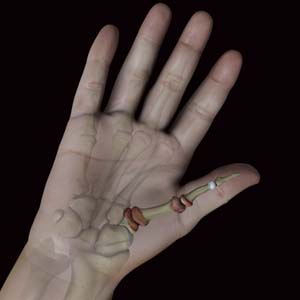
What is Arthritis of the Thumb?
Arthritis is an inflammatory condition of the joints. There are several types of arthritis. The most common type is osteoarthritis or wear-and-tear arthritis that affects the joint at the base of the thumb. Thumb arthritis is more common in women than men, and usually occurs after the age of 40 years.
Symptoms of Arthritis of the Thumb
The symptoms of arthritis of the thumb usually include swelling, pain, stiffness and deformity, all of which interfere with the use of the hand.
Diagnosis of Arthritis of the Thumb
Your doctor can usually make the diagnosis of thumb arthritis by eliciting a detailed history of the symptoms and examining the thumb. X-rays of the joint will be ordered to determine the severity of the disease, and identify any bone spurs or calcium deposits.
Treatment for Arthritis of the Thumb
Non-surgical treatment methods for relieving pain in an arthritic joint include activity modification, pain medications, and use of splints and steroid injections. Surgery is usually considered when non-surgical treatment fails to provide relief. There are different surgical procedures that can be used:
Synovectomy: This surgery is usually indicated for early cases of inflammatory arthritis where there is significant swelling (synovitis) that is causing pain or is limiting the range of motion of your digits and thumb. Synovectomy is a surgical removal of the inflamed synovium (tissue lining the joint). The procedure may be performed using arthroscopy.
Arthroplasty: In this procedure, your surgeon removes the affected joint and replaces it. Depending on the specific joint involved, the joint may be reconstructed using your native tissue or it may be replaced with an artificial implant.
Arthrodesis: A fusion, also called an arthrodesis, involves the removal of the joints and fusing the bones of the joint together using metal wires, screws or plates. The goal of this procedure is to eliminate the pain. Even though this surgery eliminates all motion at the joint, reasonable function can still be maintained.
Your surgeon will discuss the options and help you decide which type of surgery is the most appropriate for you.
Rehabilitation following Surgery for Arthritis
Following surgery, a rehabilitation program, often involving a hand or occupational therapist, may help to regain hand strength and movement. You may need to use a postoperative splint for a while after surgery to help protect the hand while it heals. You may need to restrict activities for a minimum of 12 weeks to let the joint reconstruction heal properly. Although recovery is slow, you should be able to resume your normal activities within a few months of surgery.
Related Topics
- Wrist Fracture
- Fractures of the Hand and Fingers
- Wrist Sprain
- Flexor Tendon Injuries
- Distal Radioulnar Joint (DRUJ) Arthritis
- Ulnar Nerve Compression in Guyon's Canal
- Scaphoid Facture
- Industrial Hand Trauma
- Distal Radius Osteotomy to Correct Mal-Union (Crooked Painful Wrist)
- Distal Intersection Syndrome
- Distal Biceps Avulsion
- Adult Forearm Fractures
- Arthritis of the Hand and Wrist
- Arthritis of the Thumb
- Ganglion Cyst
- Boutonniere Deformity
- Carpal Tunnel Syndrome
- De Quervain's Tendinosis
- Dupuytren's Contracture
- Hand Pain
- Hand Infections
- Trapeziometacarpal (TMC) Arthritis
- Wrist Injuries
- Wrist Tumors
- Boxer's Fracture
- Swan Neck Deformity
- Carpal Instability
- Bennett's Fracture
- Kienbock's Disease
- Scapholunate Dissociation
- Triscaphoid Joint Arthritis
- Ulnar Carpal Impaction
- Triangular Fibrocartilage Complex Injury (TFCC)
- Guyon's Canal Syndrome
- Hand Masses
- Distal Radioulnar Joint (DRUJ) Instability
- Work Related Hand Injuries
- Wrist Ligament Tear and Instability
- Metacarpophalangeal Joint Arthritis





